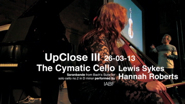The Cymatic Cello
Documentation and details of the Cymatic Cello, performed at UpClose 3, International Anthony Burgess Foundation, Manchester, UK, 26th March 2013.
Relax and unwind with a drink and enjoy a blend of classical and contemporary music at close quarters. Arrive early for contemporary sound-based artworks by John Hyatt and Lewis Sykes, taking inspiration from the music at each event. Doors open at 7.30pm.
Tues 26 March 2013 – UpClose 3 – Anthony Burgess Foundation
Bach – Suite for solo cello no. 2 in D minor – 30’
Messiaen – Quartet for the End of Time – 50’
The centre-piece of this programme is Olivier Messiaen’s Quartet for the End of Time, one of the most emotionally wrenching and spiritually reflective works written for chamber group. Written for the unusual combination of piano, violin, cello and clarinet, the work received its first performance outside in the rain in a German prisoner of war camp in 1941 on a collection of damaged instruments. This reflective programme will also include a performance by Camerata’s principal cellist, Hannah Roberts, of Bach’s D minor Cello Suite, and a new chamber work by Camerata’s composer in residence.
The Cymatic Cello
This work visualises the slow and very beautiful Sarabande from the Suite for Cello no. 2 in D minor by making visible the vibratory patterns that occur naturally on the back plate of the instrument as it’s being played. Sound can induce visible pattern and geometric formations – the modal wave patterns of Cymatics. The effect is known to some luthiers who tune their instruments according to these modes of vibration using a technique of sprinkling fine powder onto the front or back plate while playing a note of specific pitch at volume through a speaker directly below the instrument body. Lewis Sykes reproduced this technique in the studio photographing the ‘scale’ of visible patterns that emerged across the register of the cello. With Ben Lycett, he then coded an application that ‘tracks’ the pitch of the instrument during the live performance and simultaneously displays the nearest corresponding ‘tuned’ image. The visual effect is a slowly shifting, visual accompaniment to the music based on the naturally occurring vibratory patterns of the cello itself.
Biogs
Lewis Sykes is a veteran bass player of the underground dub-dance scene of the 90s. He performed and recorded with Emperor Sly, Original Hi-Fi and Radical Dance Faction and was a partner in Zip Dog Records. He honed an interest in mixed media through an MA in Hypermedia Studies at the University of Westminster in 2000 and continued to fuse music, visuals and technology through a series of creative collaborations – most notably as musician and performer with the progressive audiovisual collective The Sancho Plan (2005-2008) and more recently as one half of Monomatic – exploring sound and interaction through physical works that investigate rich musical traditions. Director of Cybersonica – an annual celebration of music, sound art and technology (2002-2011), Sykes was also Coordinator of the independent digital arts agency Cybersalon (2002-2007), founding artists-in-residence at the Science Museum’s Dana Centre. He is in the third year of a Practice as Research PhD at MIRIAD, Manchester Met, exploring the aesthetics of sound and vibration.
Ben Lycett is a visual artist, filmmaker, technologist and programmer whose work investigates where art and science collide. His outputs range from interactive installations for museums and galleries to immersive sound reactive performances in night clubs nationwide. Ben is currently a lecturer on the BA Creative Multimedia, Manchester Metropolitan University and has recently been appointed as ‘Coder-in-Residence’ for {CODE Creatives} – part of Designing our Futures, the AHRC funded, skills development programme aimed at postgraduate and early career researchers in the North West.
And some documentation on Flickr and Vimeo:
Created with flickr slideshow.
There’s also a ‘Planning for the Cymatic Cello‘ post of a collection of notes, research, reflection and links that show some of the thinking behind and development of the work at my Tumblr Digital Sketchbook.

